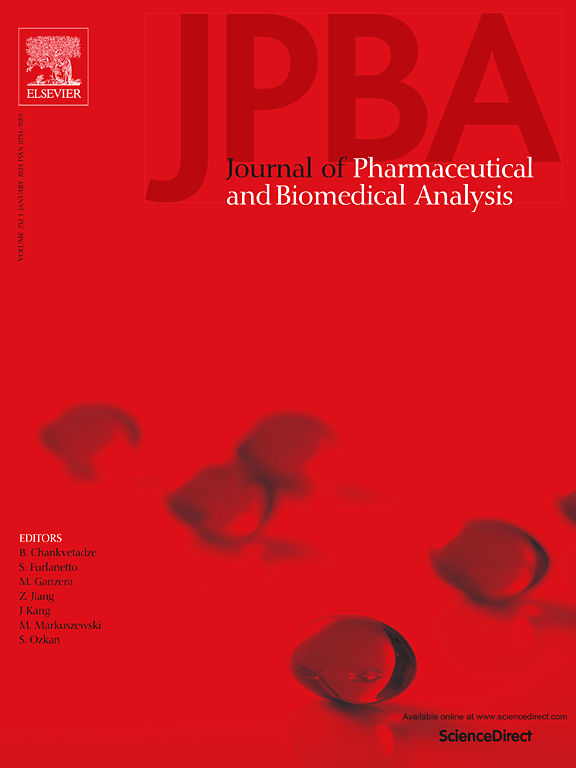Strobilanthes sarcorrhiza root phenolic extract prevent diabetic nephropathy in mice by regulating NF-κB/IL-1β signaling and glycerophospholipid metabolism
IF 3.1
3区 医学
Q2 CHEMISTRY, ANALYTICAL
Journal of pharmaceutical and biomedical analysis
Pub Date : 2024-10-20
DOI:10.1016/j.jpba.2024.116534
引用次数: 0
Abstract
Strobilanthes sarcorrhiza, a folk medicine from China, is known to treat kidney deficiency and lumbago. However, its protective effects and mechanisms against diabetic nephropathy (DN) remain unclear. This study aimed to investigate the effects and mechanisms of Strobilanthes sarcorrhiza root phenolic extract (CTS) on streptozotocin (STZ)-induced DN in mice. Firstly, the constituents in CTS were characterized by UPLC-QTOF-MS. Thirty-three constituents were identified, including 12 phenylethanoid glycosides and their derivatives, 14 phenylpropanoid glycosides derivatives, 6 polyphenols derivatives, and 1 other constituent. Then, utilizing the identified constituents of CTS, network pharmacology was used to anticipate potential pathways against DN. Thirty-two out of thirty-three constituents showed anti-DN activity; their mechanism of action was significantly linked to tumor-, glycosylation-, metabolism-related pathways, etc. Furthermore, the effectiveness of CTS against DN and its in vivo mechanism was assessed by combining immunohistochemistry, untargeted metabolomics, biochemical evaluation, and histopathological examination. The findings showed that CTS improved blood glucose and lipid levels in diabetic mice, reduced serum levels of ALT, CREA, UREA, IL-1β, and IL-17, decreased pathological damage and fibrosis in kidney tissue, and lowered the protein expression of VEGF, Laminin, TNF-α, and NF-κB in kidney tissue. Metabolomics results indicated that CTS alleviated DN mainly by regulating glycerophospholipid metabolism. To the best of our knowledge, this study is the first to report that Strobilanthes sarcorrhiza attenuates DN, potentially through the inhibition of the NF-κB pathway, leading to a reduction in the inflammatory response and fibrosis of renal tissue. These findings suggest that Strobilanthes sarcorrhiza could be a promising therapeutic agent for DN.
石斛根酚提取物通过调节 NF-κB/IL-1β 信号传导和甘油磷脂代谢预防小鼠糖尿病肾病的发生
石斛是中国的一种民间药物,具有治疗肾虚和腰痛的功效。然而,它对糖尿病肾病(DN)的保护作用和机制仍不清楚。本研究旨在探讨石斛根酚提取物(CTS)对链脲佐菌素(STZ)诱导的小鼠糖尿病肾病的作用和机制。首先,采用 UPLC-QTOF-MS 对 CTS 中的成分进行了表征。共鉴定出 33 种成分,包括 12 种苯乙醇苷及其衍生物、14 种苯丙醇苷衍生物、6 种多酚衍生物和 1 种其他成分。然后,利用已确定的 CTS 成分,采用网络药理学方法预测抗 DN 的潜在途径。在 33 种成分中,有 32 种具有抗 DN 活性;它们的作用机制与肿瘤、糖基化、新陈代谢等相关途径密切相关。此外,研究人员还结合免疫组化、非靶向代谢组学、生化评估和组织病理学检查,评估了中药对 DN 的疗效及其体内机制。结果表明,CTS能改善糖尿病小鼠的血糖和血脂水平,降低血清中ALT、CREA、UREA、IL-1β和IL-17的水平,减轻肾组织的病理损伤和纤维化,降低肾组织中VEGF、Laminin、TNF-α和NF-κB的蛋白表达。代谢组学研究结果表明,CTS主要通过调节甘油磷脂代谢来缓解DN。据我们所知,本研究是首次报道石斛通过抑制 NF-κB 通路减轻 DN,从而减轻肾组织的炎症反应和纤维化。这些研究结果表明,石斛可能是一种很有前景的 DN 治疗药物。
本文章由计算机程序翻译,如有差异,请以英文原文为准。
求助全文
约1分钟内获得全文
求助全文
来源期刊
CiteScore
6.70
自引率
5.90%
发文量
588
审稿时长
37 days
期刊介绍:
This journal is an international medium directed towards the needs of academic, clinical, government and industrial analysis by publishing original research reports and critical reviews on pharmaceutical and biomedical analysis. It covers the interdisciplinary aspects of analysis in the pharmaceutical, biomedical and clinical sciences, including developments in analytical methodology, instrumentation, computation and interpretation. Submissions on novel applications focusing on drug purity and stability studies, pharmacokinetics, therapeutic monitoring, metabolic profiling; drug-related aspects of analytical biochemistry and forensic toxicology; quality assurance in the pharmaceutical industry are also welcome.
Studies from areas of well established and poorly selective methods, such as UV-VIS spectrophotometry (including derivative and multi-wavelength measurements), basic electroanalytical (potentiometric, polarographic and voltammetric) methods, fluorimetry, flow-injection analysis, etc. are accepted for publication in exceptional cases only, if a unique and substantial advantage over presently known systems is demonstrated. The same applies to the assay of simple drug formulations by any kind of methods and the determination of drugs in biological samples based merely on spiked samples. Drug purity/stability studies should contain information on the structure elucidation of the impurities/degradants.

 求助内容:
求助内容: 应助结果提醒方式:
应助结果提醒方式:


